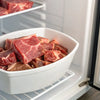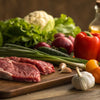Can I Feed My Dog Frozen Raw Food? A Comprehensive Guide
- Houndsy
Table of Contents
- Introduction
- Understanding Frozen Raw Food for Dogs
- How to Store Frozen Raw Dog Food
- How to Defrost Frozen Raw Dog Food
- How to Serve Frozen Raw Dog Food
- How to Clean Up After Meals
- Conclusion
Introduction
As dog lovers, we constantly seek the best options for our furry family members, and feeding practices are no exception. In recent years, many pet owners have turned toward raw food diets, with frozen raw food emerging as a popular choice. But, amid the excitement, we often find ourselves asking, can I feed my dog frozen raw food? Statistics reveal that a significant portion of dog owners, almost 50%, have considered a raw food diet. However, understanding how to safely integrate frozen raw food into our dogs' diets is essential.
In this post, we’ll explore the benefits and potential risks associated with feeding frozen raw food to dogs, including practical tips on storage, defrosting, and serving. By the end of our journey together, you’ll have a comprehensive understanding to help you make informed decisions on your dog’s feeding routine, ensuring they receive a balanced diet while you maintain a hassle-free process.
Let’s embrace the idea of simplified, enjoyable feeding experiences that enhance our beloved pets' lives.
Understanding Frozen Raw Food for Dogs
Feeding dogs a raw food diet looks much like the natural feeding behavior of their wild ancestors. The thought process behind this revolves around understanding what dogs have evolved to eat. Raw food, especially in its frozen form, mirrors this instinctual diet—consisting of raw meats, bones, organs, and sometimes raw vegetables.
Benefits of Frozen Raw Food Diets
-
Nutritional Value: Raw diets preserve the essential nutrients, vitamins, and enzymes that cooking often destroys. Frozen raw food maintains these nutrients, providing a wholesome diet.
-
Minimally Processed: Most frozen dog foods are minimally processed, making them closer to what dogs would naturally consume. This can lead to improved overall health, enhancing coat quality, digestion, and vitality.
-
Variety of Options: With a range of proteins (chicken, beef, lamb, etc.) available in frozen raw forms, pet parents can choose based on their dog's specific dietary needs or preferences.
Potential Risks of Frozen Raw Food Diets
-
Bacterial Contamination: Raw meats can harbor bacteria like Salmonella or E. coli, which can put both dogs and humans at risk if proper handling isn’t observed. Following hygienic practices is vital.
-
Digestive Upsets: Sudden switching to a raw food diet can result in digestive issues for some dogs. A gradual transition helps avoid gastrointestinal discomfort.
-
Nutritional Imbalance: Not all frozen raw diets are balanced; some might lack essential nutrients. It’s essential to choose reputable brands that offer nutritionally complete diets.
How to Store Frozen Raw Dog Food
Once you bring home your frozen raw dog food, proper storage is the first step to ensuring its safety and nutritional quality.
Freezer Storage Guidelines
-
Immediate Freezing: After purchasing, immediately place the raw food in the freezer to maintain freshness. Always check packaging for only the highest quality ingredients and ensure they are free from preservatives.
-
Temperature Control: Keep your freezer at a steady temperature of 0°F (-18°C) or lower. Fluctuations can lead to freezer burn or spoilage.
-
Containers: Store raw dog food in airtight containers or keep it in its original packing to prevent contamination and odor absorption. Avoid using worn-out containers that might leak.
-
Half-used Packs: If you open a pack, consider transferring the remaining food into a smaller airtight container to minimize exposure to air and moisture.
How to Defrost Frozen Raw Dog Food
Defrosting frozen food properly is crucial to maintaining its safety and nutritional integrity.
Recommended Defrosting Methods
-
Refrigerator Method: The safest way to defrost raw dog food is by placing it on the bottom shelf of your refrigerator overnight. This keeps it at safe temperatures throughout the thawing process.
-
Countertop Method: For same-day feeding, you can leave the frozen food at room temperature in an airtight container. Generally, this takes about 2-4 hours depending on the food's density.
-
Cool Water Bath: If you're short on time, place the sealed raw food in a bowl of cool water. This decides thawing time and can help maintain the food’s integrity.
Important Notes on Defrosting
-
Never microwave raw dog food: Microwaving can cause uneven heating, leading to potential bacterial growth and nutrient loss.
-
Avoid refreezing: Once you’ve thawed raw food, do not refreeze it. This promotes bacterial growth and compromises food quality.
-
Use within a time frame: Feed your dog the defrosted food within 24 hours to prevent spoilage.
How to Serve Frozen Raw Dog Food
Feeding your dog raw food can be a simple yet rewarding experience when done right.
Service Procedures
-
Portion Control: Use a culinary scale to measure an appropriate amount based on your dog’s size, age, and energy level. The general rule of thumb for adult dogs is 2-3% of their body weight in raw food. Checking with a veterinarian for personalized recommendations is ideal.
-
Hygiene Practices: Always wash your hands before and after handling raw food. Clean surfaces and utensils with hot, soapy water or disinfectant to avoid cross-contamination.
-
Serving Temperature: Ideally, serve defrosted raw food at room temperature, as cold food can be unappealing to some dogs.
-
Monitor Feeding: Take note if your dog has any adverse reactions to the new routine, like digestive upsets or behavior changes.
How to Clean Up After Meals
Establishing a cleaning routine is essential after serving raw food to ensure your kitchen remains safe and hygienic.
Cleaning Practices
-
Immediate Cleanup: After your dog finishes their meal, promptly remove their bowl, scraping any leftover food into the trash. Leaving food out longer than two hours can lead to spoilage or attract pests.
-
Washer-Friendly Bowls: Use dishwasher-safe bowls when possible. This allows for high-temperature washing, which effectively sanitizes them.
-
Sanitize Surfaces: Clean the area where the feeding occurred using appropriate disinfectants to eliminate any leftover bacteria.
Best Practices for Bowls and Utensils
Opt for metal or ceramic bowls, as these materials are less prone to harboring bacteria compared to plastic or wooden options. Avoid using anything porous for food preparation or serving.
Conclusion
Feeding dogs frozen raw food can be an enriching experience for you and your furry friend, offering numerous health benefits and simplifying mealtime rituals. As we’ve learned, addressing concerns surrounding safety, nutrition, and cleanliness is critical for a successful and enjoyable eating experience.
By implementing the storage, defrosting, and serving techniques discussed in this guide, pet owners can embrace raw feeding with confidence. If you’re considering enhancing your dog’s feeding experience even further, let’s not forget how our Houndsy Kibble Dispenser revolutionizes mealtime with its stylish, ergonomic design, making feeding time a breeze. Order Now and see how it can simplify your feeding routine.
Frequently Asked Questions (FAQs)
Can I feed my dog frozen raw food as a complete diet?
Yes, as long as it is high-quality, nutritionally balanced frozen raw food, it can serve as a complete diet. Always check labels for nutritional information.
Is it safe for dogs to eat raw food?
While raw food can present some risks, proper handling and hygiene practices can minimize these dangers. Many dogs thrive on raw food diets when appropriately managed.
How should I transition my dog to frozen raw food?
Gradually mix a small amount of frozen raw food with their current food, slowly increasing the raw portion over 7-10 days until fully transitioned.
Can dogs eat frozen raw bones?
While some dogs can chew frozen raw bones, it is generally advised to thaw bones before serving to prevent potential dental issues or choking.
What types of raw food should I avoid?
Avoid raw dog foods not labeled as 'complete and balanced,' as they may not offer the necessary nutrients. It's also vital to avoid any raw products containing known allergens for your pet.
By approaching frozen raw food feeding with care and informed practices, we can provide our beloved pets with meals they’re instinctively drawn to, all while ensuring safety and nutrition. Here’s to many happy, healthy meals together!













